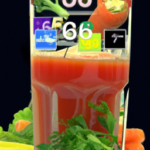Juice Tips and Tricks
How Much Sodium In V8 Juice

If you care about your health, you probably know the saying, “you are what you eat.” This simple yet powerful idea emphasizes the importance of being conscious about our food choices.
One popular option for health-conscious individuals is V8 juice, a vegetable juice that boasts numerous health benefits. However, as with any food or drink, it’s important to know what you’re putting into your body, especially when it comes to sodium intake.
Sodium is an essential mineral that plays a crucial role in regulating our body’s fluid balance and nerve function. However, consuming too much sodium can lead to a host of health problems, including high blood pressure, heart disease, and stroke.
In this article, we’ll take a closer look at how much sodium is in V8 juice, as well as explore the health risks of consuming too much sodium and low-sodium alternatives to V8 juice. So, let’s dive in and learn more about the sodium content in V8 juice.
Key Takeaways
- V8 juice can be a convenient way to meet daily recommended intake of vitamins and minerals
- Original V8 juice contains a high amount of sodium, which can contribute to health problems with excessive intake
- Low-sodium versions of V8 juice are available as a healthier alternative
- It’s important to understand recommended serving sizes and moderation when consuming vegetable juice to avoid consuming too much sodium
The Importance of Sodium Intake
It’s crucial to consider one’s sodium intake when maintaining a healthy diet. Sodium is a mineral that our bodies need in small amounts to maintain fluid balance and nerve and muscle function. However, consuming too much sodium can lead to high blood pressure, increasing the risk of heart disease and stroke.
The recommended intake of sodium per day is no more than 2,300 milligrams for adults, and even less for those with certain health conditions such as high blood pressure. The main sources of sodium in our diets come from processed foods, such as fast food, canned soups, and packaged snacks.
By being mindful of these sources, we can make conscious choices to reduce our sodium intake and improve our overall health. With this in mind, let’s take a closer look at the sodium content in V8 juice as a popular beverage choice.
Overview of V8 Juice
V8 Juice contains a blend of vegetables that can help you meet your daily recommended intake of vitamins and minerals. This popular juice is made from a mixture of vegetables such as tomatoes, carrots, beets, celery, and spinach, among others.
It is available in various flavors, including original, spicy hot, low-sodium, and splash. Apart from its nutritional benefits, V8 Juice is also a tasty drink that comes in different flavors to suit your taste preferences.
The original flavor has a savory taste that is perfect for those who enjoy the pure taste of vegetables, while the spicy hot flavor adds a kick of spice to the mix. Additionally, the low-sodium and splash flavors offer alternatives for those watching their sodium intake or who prefer a fruitier taste.
Overall, V8 Juice is a convenient and delicious way to incorporate vegetables into your daily diet. With that said, it’s important to note the sodium content in V8 Juice, which will be discussed in the next section.
Sodium Content in V8 Juice
You may want to be mindful of the amount of salt present in this popular vegetable drink. While V8 juice is generally considered a healthy beverage, it’s important to remember that it contains a significant amount of sodium.
Benefits of sodium include regulating fluid balance, maintaining nerve and muscle function, and supporting heart health. However, the recommended intake levels for sodium are no more than 2,300 milligrams per day for most adults, with an ideal limit of 1,500 milligrams for those with high blood pressure, diabetes, or kidney disease.
The sodium content in V8 juice varies based on the specific variety. For example, the Original V8 juice contains 640 milligrams of sodium per 8-ounce serving, while the Low Sodium version contains only 140 milligrams. Other varieties, such as the V8 Spicy Hot and V8 Bloody Mary Mix, may contain even more sodium due to added spices and seasonings.
It’s important to check the nutrition label before consuming any variety of V8 juice to ensure it aligns with your recommended daily sodium intake. With this information in mind, let’s now delve into the potential health risks of consuming too much sodium.
Health Risks of Consuming Too Much Sodium
Consuming excessive amounts of sodium can lead to a range of health consequences. The recommended daily intake of sodium is 2,300 milligrams for healthy adults, and even lower for those with high blood pressure or other health conditions.
When we consume too much sodium, our body retains water to dilute the sodium concentration in our bloodstream. This extra fluid puts pressure on our blood vessels, leading to high blood pressure, which can increase our risk of heart disease and stroke.
In addition to these immediate health risks, a diet high in sodium can have long-term consequences. Over time, high blood pressure can damage our blood vessels, making it more difficult for blood to flow through our body. This can lead to a range of health problems, including kidney disease, vision loss, and cognitive decline.
For these reasons, it’s important to be mindful of our sodium intake and choose low-sodium alternatives whenever possible. One low-sodium alternative to consider is opting for fresh fruits and vegetables instead of processed foods. These whole foods are naturally low in sodium and provide a range of other nutrients that are important for our health.
Another option is to make your own vegetable juice at home using fresh ingredients and limited added salt. By making small changes to our diet, we can reduce our sodium intake and lower our risk of these serious health consequences.
Low-Sodium Alternatives to V8 Juice
I’ve been trying to cut down on my sodium intake lately, and one way I’ve been doing that is by exploring low-sodium alternatives to V8 juice.
I’ve found that making my own vegetable juice is a great option because I can control the ingredients and the amount of sodium.
I’ve also discovered some store-bought low-sodium vegetable juices that are tasty and convenient.
Homemade Vegetable Juice Recipes
Feeling adventurous in the kitchen? Try making your own vegetable juice at home! Juicing techniques have come a long way, and there are plenty of options available to create a delicious and healthy drink.
You can use a juicer or a blender to extract the juice from your favorite vegetables, such as carrots, beets, kale, spinach, and cucumbers. Experiment with different flavor combinations to find the perfect mix for your taste buds. Some popular options include adding ginger or lemon for a zesty kick, or using apples or berries to sweeten the juice.
Making your own vegetable juice at home is not only a fun and creative way to get your daily dose of vitamins and minerals, but it’s also a healthier alternative to store-bought options. Store-bought low-sodium vegetable juices often contain added sugars or preservatives, which can undermine the benefits of the juice.
By making your own juice, you can control the ingredients and ensure that you’re getting the most nutrient-dense drink possible. So why not give it a try and see how easy and delicious it can be?
Store-Bought Low-Sodium Vegetable Juices
Now that we’ve explored some homemade vegetable juice recipes, let’s take a look at store-bought low-sodium vegetable juices. While making your own juice at home can be a fun and cost-effective way to enjoy the benefits of juicing, store-bought options can be a convenient and time-saving alternative.
Many popular vegetable juice brands offer low-sodium options that are perfect for those who are watching their salt intake. One popular brand is V8, which offers a low-sodium version of their original vegetable juice. This juice contains only 140mg of sodium per serving, compared to the 640mg found in the regular version. Other brands, such as Naked Juice, also offer low-sodium vegetable juice options.
Incorporating store-bought low-sodium vegetable juices into your diet can be a great way to get the benefits of juicing without the hassle of making your own juice from scratch.
Speaking of nutrition, it’s important to know how to read nutrition labels to ensure you’re making healthy choices. Let’s take a closer look at how to do just that in the next section.
How to Read Nutrition Labels
You can easily understand the nutrition information on food labels by looking for key values like calories, serving size, and sodium content. Reading comprehension is important when it comes to interpreting label claims, which can sometimes be misleading. For example, a package may advertise ‘low sodium,’ but upon closer inspection, the sodium content per serving may still be relatively high.
This is why it’s important to pay attention to the serving size listed on the label, as well as the daily recommended intake of sodium. When checking the sodium content, keep in mind that the American Heart Association recommends consuming no more than 2,300 milligrams of sodium per day, and ideally, aiming for just 1,500 milligrams per day.
To put this into perspective, a single teaspoon of table salt contains about 2,300 milligrams of sodium. Tips for reducing sodium intake include opting for fresh or frozen fruits and vegetables, cooking with herbs and spices instead of salt, and selecting low-sodium or sodium-free options when grocery shopping.
Tips for Reducing Sodium Intake
Opt for fresh or frozen fruits and vegetables, use herbs and spices instead of salt, and choose low-sodium or sodium-free options while grocery shopping to reduce your daily intake of sodium and improve your overall health. Making healthy swaps is a great way to reduce your sodium intake. For example, instead of reaching for potato chips or crackers for a snack, choose fresh fruit or vegetables like carrots or cucumbers. Additionally, try swapping out salty condiments like ketchup or soy sauce for flavorful seasonings like lemon juice, garlic, or hot sauce.
Another way to reduce your sodium intake is to choose low-sodium or sodium-free options while grocery shopping. Look for foods labeled "low-sodium"or "sodium-free"and compare labels to find the option with the lowest amount of sodium. This can also be applied to canned or frozen fruits and vegetables – look for those labeled as "no salt added"or "unsalted."By making these simple changes, you can improve your overall health and reduce your risk of high blood pressure and other health conditions associated with high sodium intake.
Incorporating these healthy swaps and selecting low-sodium options while grocery shopping can have a significant impact on your sodium intake and overall health. By reducing your sodium intake, you can lower your risk of high blood pressure, stroke, and heart disease. In the next section, we will explore other health benefits of vegetable juices.
Other Health Benefits of Vegetable Juices
If you’re looking to add a healthy boost to your diet, vegetable juices can be a great option. The benefits of juicing go beyond just hydration, as vegetable juices are packed with nutrients to give you a kickstart and help you hit the ground running.
Whether you’re looking for a quick energy boost or trying to incorporate more vitamins and minerals into your diet, vegetable juices can be a convenient and nutritious option. Nutrients in vegetable juices can vary depending on the vegetables used, but some common nutrients include vitamin C, vitamin A, potassium, and iron.
These nutrients are essential for maintaining a healthy immune system, promoting healthy skin and hair, and supporting healthy heart function. Incorporating vegetable juices into your diet can help you meet your daily recommended intake of these important nutrients. So why not try adding a glass of vegetable juice to your breakfast routine or as a mid-afternoon pick-me-up? Your body will thank you for it.
When it comes to making informed choices about your diet, it’s important to consider not only the nutrients you’re consuming, but also the potential downsides such as added sugars and sodium. One common concern with vegetable juices is their sodium content. So, how much sodium in V8 juice? We’ll explore that in the next section.
Making Informed Choices About Your Diet
Now that we’ve discussed the various health benefits of vegetable juices, it’s important to consider how much sodium is in these drinks. While vegetable juices can be a great way to consume important nutrients and vitamins, they can also be high in sodium, which can lead to negative health outcomes like high blood pressure.
It’s important to make informed choices about your diet and to understand the nutritional benefits of the foods and drinks you consume. To make sure you’re getting the most out of your vegetable juice, it’s important to check the label and understand the recommended serving size.
While vegetable juices can be a great way to get important nutrients and vitamins in your diet, it’s important to consume them in moderation and to make sure you’re not consuming too much sodium. Here are some tips for making informed choices about your diet:
- Check the label for the sodium content of your vegetable juice
- Understand the recommended serving size for the juice
- Consider mixing your vegetable juice with water to reduce the sodium content
- Look for low-sodium vegetable juice options
- Consider making your own vegetable juice at home to have more control over the ingredients and sodium content.
By following these tips, you can ensure that you’re getting the most out of your vegetable juice and making informed choices about your diet. Remember to always check the label and understand the recommended serving size to avoid consuming too much sodium.
Frequently Asked Questions
What are the other ingredients in V8 juice besides sodium?
I find V8 juice’s nutritional value to be well-rounded, as it contains a blend of eight different vegetables. The taste profile is a balance of savory and slightly sweet. Other ingredients include tomato juice, carrot juice, and celery juice.
Can V8 juice be harmful for people with high blood pressure or heart disease?
For those with high blood pressure or heart disease, it’s important to balance sodium intake. V8 juice can be high in sodium, so alternatives may be better. Consult with a healthcare provider for personalized advice.
How does the sodium content in V8 juice compare to other vegetable juices?
When comparing sodium content in vegetable juices, V8 juice tends to be on the higher end. However, it still provides a range of nutritional values, such as vitamins A and C, and can be a healthy addition to a balanced diet.
Is it safe to consume V8 juice on a daily basis?
Coincidentally, I was just researching the benefits and risks of consuming V8 juice daily. While it is a good source of nutrients, the high sodium content may be concerning. Alternatives or substitutes with lower sodium options may be a better choice.
Are there any natural ways to enhance the flavor of low-sodium vegetable juices?
I’ve found that adding a squeeze of lemon or lime, a pinch of cayenne pepper, or a few sprigs of fresh herbs like basil or mint can be natural enhancers to achieve flavor balance in low-sodium vegetable juices.
Conclusion
So, how much sodium is in V8 juice? As someone who’s conscious about their sodium intake, I’m happy to report that V8 juice offers a low-sodium option for those looking to incorporate more vegetables into their diet.
With only 140mg of sodium per serving, V8 juice is a great alternative to other high-sodium beverages.
However, some may argue that the taste of low-sodium V8 juice is lacking compared to its regular counterpart. While it’s true that the reduced sodium content may affect the flavor slightly, it’s important to remember that our taste buds can adapt and adjust to changes in our diet over time.
Plus, the health benefits of consuming more vegetables through V8 juice far outweigh any perceived taste differences.
So, next time you’re at the grocery store, reach for a low-sodium V8 juice and enjoy the many health benefits it has to offer.
Cindy thoroughly researches juicing trends, techniques, and recipes to provide readers with practical advice and inspiration. Her writing style is accessible, engaging, and designed to make complex concepts easy to understand. Cindy’s dedication to promoting the advantages of juicing shines through her work, empowering readers to make positive changes in their lives through the simple act of juicing.
Juice Tips and Tricks
How to Make Aloe Vera Juice Taste Better

Tired of the strong flavor of aloe vera juice? No problem, we’ve got the answer for you.
In this article, we’ll share some tips and tricks to make your aloe vera juice taste better. We have tried and tested various methods to enhance the flavor without compromising the health benefits.
From choosing the right juice to adding natural sweeteners and infusing with fruits and herbs, we’ve got all the information you need to transform your aloe vera juice into a delightful and refreshing beverage.
Let’s dive in!
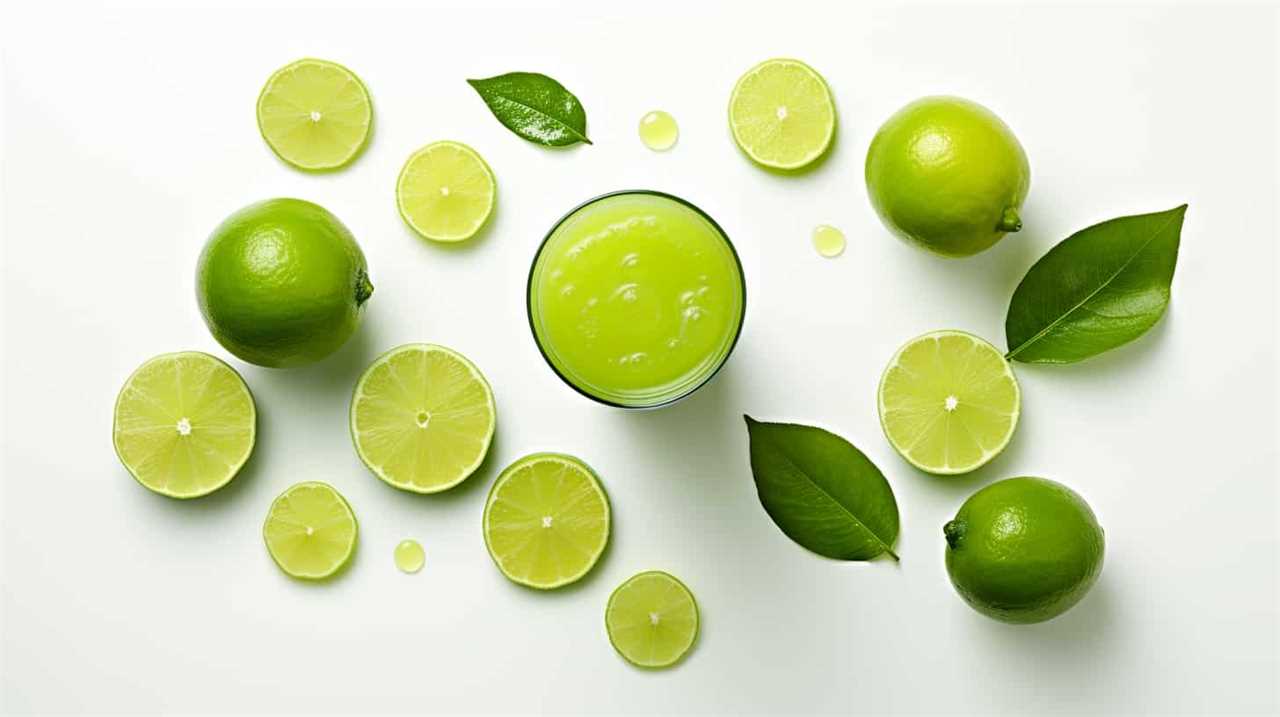
Key Takeaways
- Choose a reputable brand of aloe vera juice that prioritizes quality and uses organic, pure aloe vera.
- Avoid brands that contain added sugars or artificial ingredients.
- Use natural sweeteners like honey, agave syrup, or stevia to enhance the taste of aloe vera juice.
- Experiment with adding fruits, herbs, and other juices to create unique flavor combinations and enhance the health benefits of aloe vera juice.
Choosing the Right Aloe Vera Juice
We can enhance our experience with aloe vera juice by selecting the right brand and type for our preferences. When it comes to finding a reputable brand, it’s important to do some research and read reviews from other consumers. Look for brands that prioritize quality and use organic, pure aloe vera without any added sugars or artificial ingredients. Understanding the health benefits of aloe vera juice is also crucial in making the right choice. Aloe vera is known for its soothing properties, aiding digestion, promoting skin health, and boosting the immune system. By choosing a high-quality brand, we can ensure that we’re getting the maximum benefits from our aloe vera juice.
Now that we know how to choose the right brand, let’s move on to the next step of adding natural sweeteners.
Adding Natural Sweeteners
To enhance the flavor of our aloe vera juice, we can add natural sweeteners such as honey or agave syrup. Using alternative sweeteners not only adds sweetness but also brings unique flavors to the juice. Here are some options to consider:
- Stevia: A natural sweetener derived from the Stevia plant, it’s a zero-calorie alternative to sugar.
- Maple Syrup: This natural sweetener adds a rich and earthy flavor to the aloe vera juice.
- Dates: Pureed dates can be used to sweeten the juice while also providing essential nutrients like fiber.
In addition to using alternative sweeteners, we can enhance the flavor of aloe vera juice by adding spices and extracts. Cinnamon, ginger, or vanilla extract can add warmth and depth to the taste. By experimenting with different combinations of these natural sweeteners, spices, and extracts, we can create a flavor profile that suits our preferences.

Now, let’s move on to the next section and learn how to infuse aloe vera juice with fruits and herbs to further enhance its taste.
Infusing With Fruits and Herbs
As we explore ways to make our aloe vera juice taste better, one option to consider is infusing it with fruits and herbs. Creating unique aloe vera blends by adding fruits and herbs not only enhances the flavor but also adds a touch of freshness and complexity to the juice.
Fruits like strawberries, pineapple, or citrus can add a burst of sweetness, while herbs like mint, basil, or ginger can provide a subtle yet refreshing twist. Exploring the benefits of herbal infusions can also be beneficial for our health. For example, adding a few sprigs of lavender can promote relaxation and reduce stress. Additionally, infusing aloe vera juice with rosemary can aid digestion and boost the immune system.
Blending With Other Juices
Let’s try mixing aloe vera juice with different fruit juices to create delicious and refreshing blends. Blending aloe vera juice with other fruits not only enhances its taste but also adds nutritional benefits to your drink. Here are three fruit juices that you can mix with aloe vera juice:

- Orange juice: Combining aloe vera juice with orange juice not only adds a tangy flavor but also boosts your intake of vitamin C, which is essential for a strong immune system.
- Pineapple juice: Mixing aloe vera juice with pineapple juice creates a tropical blend that isn’t only refreshing but also helps in digestion. Pineapple contains bromelain, an enzyme that aids in breaking down proteins and promoting better digestion.
- Watermelon juice: Blending aloe vera juice with watermelon juice creates a hydrating and refreshing combination. Watermelon is rich in water content and contains electrolytes that can help replenish your body’s fluids.
Experimenting With Flavor Combinations
While we can try various flavor combinations with aloe vera juice, it’s important to find the right balance to enhance its taste. Experimenting with different flavors can’t only make the juice more enjoyable but also enhance its health benefits.
Aloe vera juice is known for its numerous health benefits, such as boosting digestion, promoting hydration, and supporting the immune system. By adding complementary flavors, we can create a refreshing summer drink that not only tastes great but also provides a nutritional boost.
Some popular flavor combinations include mixing aloe vera juice with citrus fruits like lemon or orange, adding a splash of coconut water for a tropical twist, or combining it with cucumber and mint for a refreshing and cooling effect.
Don’t be afraid to get creative and find the flavor combination that suits your taste buds best!

Frequently Asked Questions
Can I Use Store-Bought Aloe Vera Gel Instead of Fresh Aloe Vera for Making Juice?
Yes, you can use store-bought aloe vera gel instead of fresh aloe vera for making juice. However, it’s important to note that fresh aloe vera juice may have more health benefits due to its higher nutrient content.
How Long Can I Store Aloe Vera Juice in the Refrigerator?
Aloe vera juice can be stored in the refrigerator for up to a week. Refrigeration helps maintain the longevity and freshness of the juice, preserving its beneficial properties.
Can Aloe Vera Juice Help With Digestive Issues?
Aloe vera juice can potentially help with digestive issues when taken in appropriate dosages. However, it is important to note that there may be potential side effects. It is always best to consult with a healthcare professional before starting any new supplement regimen.
Can I Use Artificial Sweeteners Instead of Natural Sweeteners in My Aloe Vera Juice?
Using artificial sweeteners in aloe vera juice may affect its taste and potential health benefits. However, natural sweeteners like honey or stevia can enhance the flavor without compromising its nutritional value.

Is It Safe to Drink Aloe Vera Juice Every Day?
Drinking aloe vera juice daily can have numerous benefits, such as improving digestion and boosting the immune system. However, consuming it regularly may also lead to potential side effects like diarrhea or stomach cramps.
Conclusion
In conclusion, making aloe vera juice taste better is easy and enjoyable.
By choosing the right aloe vera juice and adding natural sweeteners, infusing with fruits and herbs, blending with other juices, and experimenting with flavor combinations, you can create a delightful and refreshing drink.
So go ahead and unleash your creativity in the kitchen, and transform your aloe vera juice into a sensational elixir that will transport your taste buds to paradise.
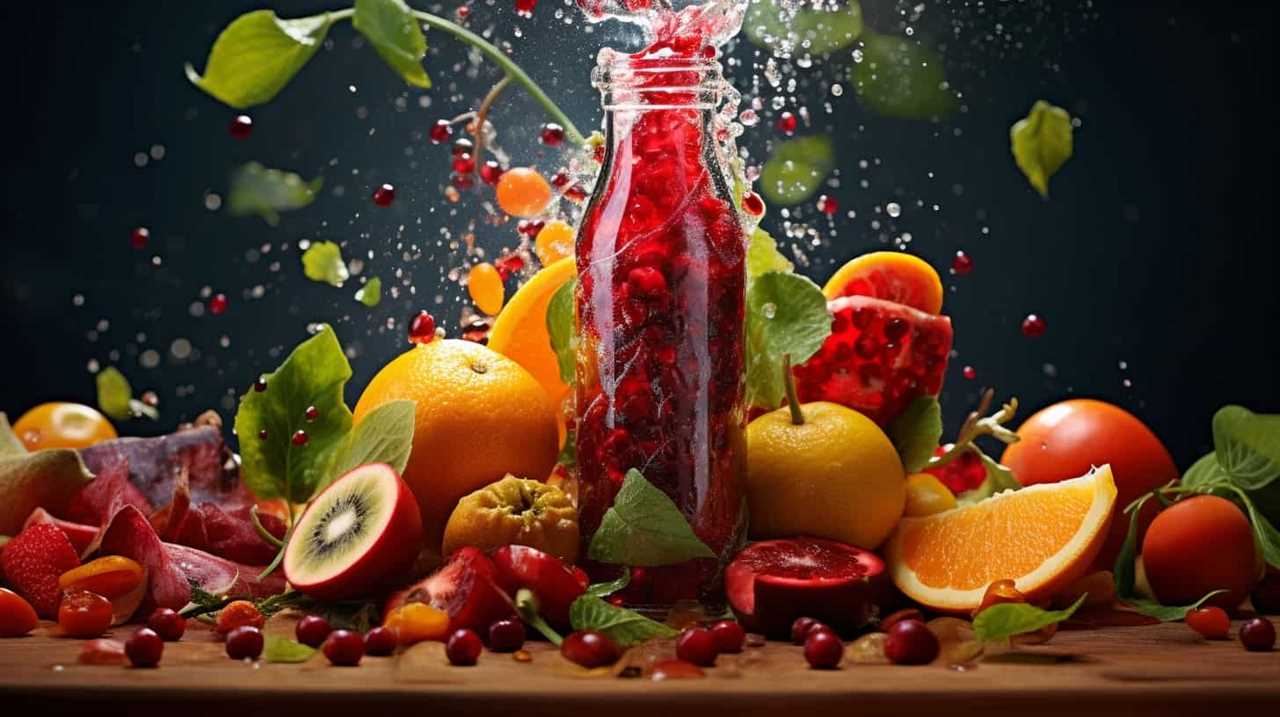
Susannah expertise lies in researching and compiling evidence-based content on juicing, nutrition, and overall health. She is committed to ensuring that The Juicery World offers accurate, up-to-date, and trustworthy information to empower readers to take control of their health. Susannah’s goal is to inspire individuals to embrace juicing as a way to nourish their bodies and live their best lives.
Juice Tips and Tricks
How to Make a Glass of Lemonade With Bottled Lemon Juice

Are you craving a cool glass of lemonade to quench your thirst? Look no further! Try out our perfect recipe using bottled lemon juice that will surely please your taste buds.
In this article, we’ll guide you through the process of creating a tangy and sweet concoction that will leave you feeling refreshed and satisfied.
So grab your ingredients and let’s get started on this delightful journey of serving ourselves and others a glass of pure lemony goodness.
Key Takeaways
- Consider the storage of the bottled lemon juice (dark glass or plastic bottles, protect from light exposure, check expiration date)
- Choose a suitable pitcher and fresh lemons for enhanced flavor
- Store the lemonade concentrate in the refrigerator to maintain freshness
- Adjust the sweetness and tartness to taste with sugar or more lemon juice, and experiment with different sweeteners or additional flavors.
Choosing the Right Bottled Lemon Juice
What are the key factors we should consider when selecting the right bottled lemon juice for our lemonade?

One important factor is how the lemon juice is stored. Look for bottles that are made of dark glass or plastic, as they help protect the juice from light exposure, which can degrade its quality. It’s also important to check the expiration date to ensure freshness.
Another benefit of using bottled lemon juice is convenience. It saves time and effort compared to squeezing fresh lemons. Additionally, bottled lemon juice provides consistent flavor, as the acidity levels are standardized.
When selecting a brand, consider reading reviews and checking for certifications, such as organic or non-GMO.
Gathering the Necessary Ingredients and Tools
How can we gather all the necessary ingredients and tools to make a glass of lemonade with bottled lemon juice?
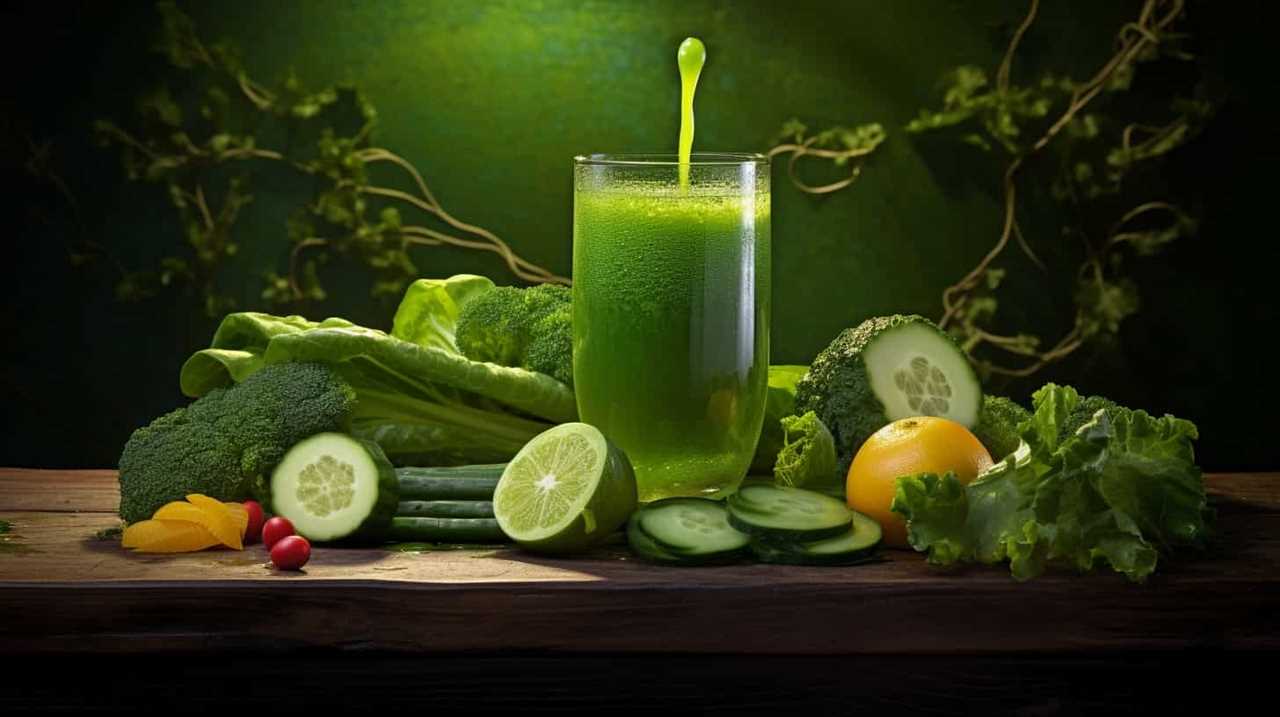
It’s important to start with the right pitcher. Look for a pitcher that’s made of glass or BPA-free plastic, as these materials won’t affect the taste of the lemonade. The pitcher should also have a lid or cover to keep the lemonade fresh and prevent spills.
Now, let’s talk about the lemons. While bottled lemon juice is convenient, using fresh lemons instead can elevate the flavor of your lemonade. Choose lemons that are firm and have a bright yellow color. Give them a gentle squeeze to ensure they’re juicy. To extract the juice, you’ll need a citrus juicer or a reamer. These tools make it easy to get every last drop of juice from the lemons.
Mixing the Lemonade Concentrate
To start mixing the lemonade concentrate, we’ll slowly pour the bottled lemon juice into the pitcher. It’s important to choose the right container for the lemonade concentrate. A pitcher with a lid or a tightly sealed container will help maintain the freshness and prevent any spills or leaks. Once the lemon juice is in the pitcher, we can move on to the next step of adding water and sweetener.
To ensure the lemonade concentrate stays fresh, it’s essential to store it properly. Keep the pitcher in the refrigerator to maintain its cool temperature and prevent any bacteria growth. If you have any leftover concentrate, transfer it to a smaller container with an airtight lid before refrigerating. This will help retain its flavor and prevent any contamination.

Now that we’ve mixed the lemonade concentrate, it’s time to adjust the sweetness and tartness to taste.
Adjusting the Sweetness and Tartness to Taste
We can adjust the sweetness and tartness of the lemonade to taste by adding more sugar or lemon juice, respectively. If you prefer a sweeter lemonade, simply add more sugar and stir until it dissolves completely. You can experiment with different sweeteners such as honey or agave syrup to find the perfect balance of sweetness.
On the other hand, if you want a tangier lemonade, add more lemon juice gradually, tasting as you go until it reaches your desired level of tartness.
Additionally, you can get creative with your lemonade by adding flavors like fresh mint leaves or a hint of lavender. These additions can elevate the flavor profile and create a more refreshing and unique experience.

Now that we’ve adjusted the sweetness and tartness of our lemonade, let’s move on to serving and enjoying your refreshing glass of lemonade.
Serving and Enjoying Your Refreshing Glass of Lemonade
Now let’s sit back, relax, and savor our refreshing glass of lemonade.
When it comes to serving and enjoying this delightful drink, there are a few techniques and garnishing options to consider.
Firstly, serving your lemonade chilled is essential for maximum enjoyment. Ensure that you have chilled glasses or add ice cubes to the glasses before pouring the lemonade.

To add a touch of elegance, you can garnish your lemonade with a slice of lemon on the rim of the glass. For an extra burst of flavor, you could also add a sprig of fresh mint or a few berries.
Remember to gently stir the lemonade before serving to evenly distribute the flavors.
Now, take a sip, feel the refreshing tang of lemon, and let the sweet and tart flavors dance on your taste buds.
Cheers!
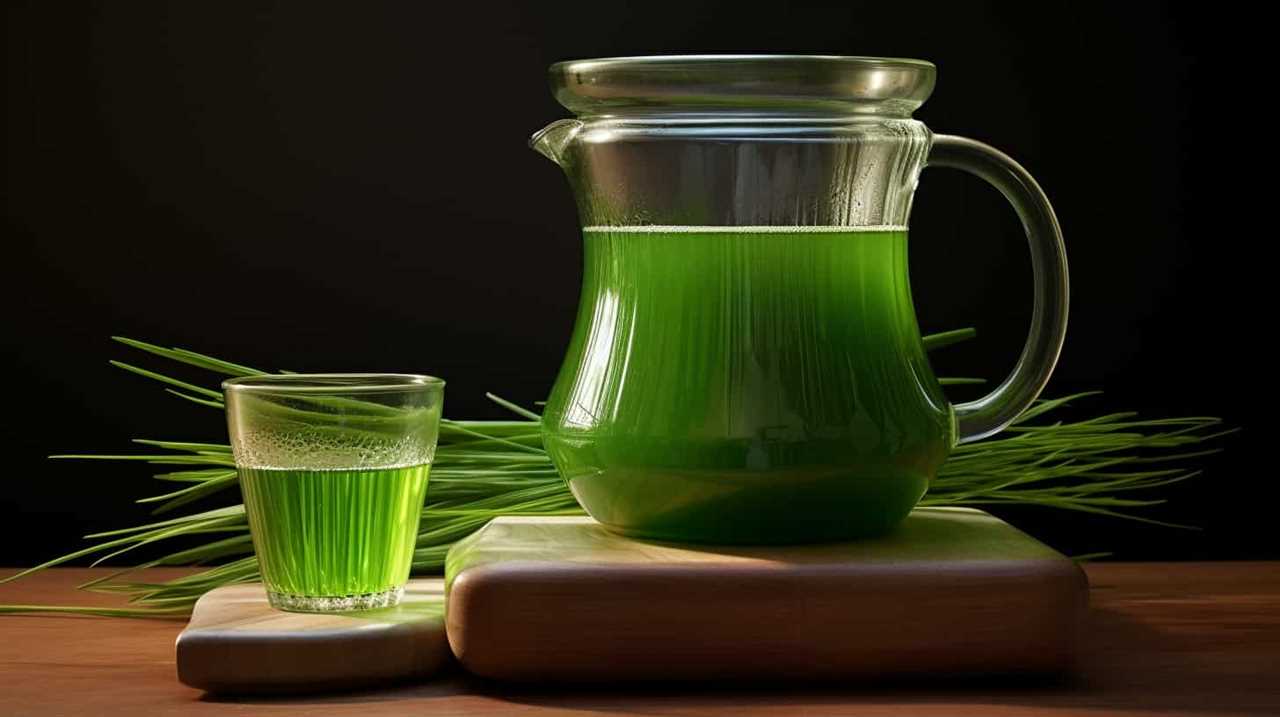
Frequently Asked Questions
Can I Use Fresh Lemons Instead of Bottled Lemon Juice?
Fresh lemons offer numerous benefits over bottled lemon juice. The taste of fresh lemons is unparalleled, providing a vibrant and tangy flavor. Incorporating fresh lemons into your lemonade will elevate its taste and give it a refreshing and authentic twist.
Can I Substitute Sugar With a Different Sweetener?
Substituting sweeteners in lemonade can enhance the flavor and offer health benefits. We’re knowledgeable about alternative sweeteners and can provide precise, detailed instructions on using them in place of sugar.
How Long Does the Lemonade Concentrate Need to Chill in the Refrigerator?
The chilling time for the lemonade concentrate in the refrigerator is typically around 1-2 hours. Using bottled lemon juice offers the benefit of convenience and consistent flavor for a refreshing glass of lemonade.
Can I Add Other Fruits or Flavors to the Lemonade?
Sure, we can definitely add different fruits or flavors to our lemonade. It’s a great way to experiment with unique flavors and create refreshing, personalized drinks. The possibilities are endless!

How Long Does the Lemonade Stay Fresh in the Refrigerator?
Lemonade made with bottled lemon juice can stay fresh in the refrigerator for about 5-7 days. To maximize shelf life, store it in an airtight container and keep it chilled.
Conclusion
And so, with a few simple steps and the right ingredients, a glass of refreshing lemonade is born.
Like a symphony of flavors dancing on your taste buds, this tangy elixir quenches thirst and brings joy on a hot summer day.
Just a sip transports you to a world of citrusy delight, where the sweetness and tartness blend harmoniously.

So go ahead, indulge in the art of lemonade-making and savor every drop of this sun-kissed nectar.
Cheers to the perfect glass of lemonade!
Susannah expertise lies in researching and compiling evidence-based content on juicing, nutrition, and overall health. She is committed to ensuring that The Juicery World offers accurate, up-to-date, and trustworthy information to empower readers to take control of their health. Susannah’s goal is to inspire individuals to embrace juicing as a way to nourish their bodies and live their best lives.
Juice Tips and Tricks
How to Know if Orange Juice Is Bad

We’ve all been in that situation before – reaching for a glass of orange juice and hesitating, unsure if it’s still okay to drink. Fear not! This article will give you the knowledge you need to determine for sure if your orange juice is still fresh or if it’s gone bad.
With a blend of scientific precision and practical tips, we’ll explore color changes, strange smells, off taste, texture changes, and mold or growth that may indicate spoilage.
Let’s dive in and serve ourselves a refreshing glass of certainty!
Key Takeaways
- Color changes in orange juice can indicate a loss of freshness and shelf life extension, but it doesn’t necessarily mean the juice is bad.
- Unusual or off-putting odors in orange juice, such as sour or fermented scents, can be a sign of poor quality.
- An off taste in orange juice, such as sour, bitter, or fermented flavors, suggests that the juice is spoiled.
- Texture changes in orange juice, such as pulp separation or a thicker consistency, can occur as the juice ages, so it’s important to consume it before the expiration date.
Color Changes in Orange Juice
We should be aware that color changes can indicate whether orange juice is bad.

When it comes to orange juice, color is a crucial factor to consider. As oranges are exposed to air, an oxidation process occurs, which leads to changes in color. Fresh orange juice has a vibrant orange hue, indicating its freshness and high nutritional value.
However, as time passes, the juice may undergo a color change, turning dull or brownish. This change in color is a result of the oxidation process, which affects the flavor and quality of the juice. It’s important to note that while a change in color doesn’t necessarily mean the juice is bad, it does indicate that the juice is losing its freshness and shelf life extension.
Therefore, it’s advisable to consume orange juice when it’s at its freshest, as indicated by its vibrant orange color.
Strange Smells in Orange Juice
When it comes to evaluating orange juice, we should be cautious of any strange smells or odors. A fresh, pleasant smell is indicative of good quality orange juice. However, if you notice any unusual or off-putting odors, it may be a sign that the juice has gone bad. These smells can range from a sour or fermented scent to a rancid or moldy aroma.

It’s important to note that while some natural variations in scent can occur due to the specific variety of oranges used, any strong or unpleasant smells should raise concerns. If you have citrus fruit allergies, it’s especially important to pay attention to the smell of orange juice, as it could indicate the presence of spoilage or contamination.
Ensuring the quality of orange juice is essential as it’s a popular beverage known for its health benefits, including being rich in vitamin C and antioxidants.
Off Taste of Orange Juice
Our taste buds can detect even the slightest hint of an off taste in orange juice, which can indicate that it has gone bad. The taste of orange juice should be fresh, tangy, and slightly sweet. If it tastes sour, bitter, or fermented, it’s likely spoiled.
One common cause of an off taste in orange juice is the use of overripe oranges. When oranges become overripe, their flavor profile changes, resulting in a less pleasant taste. Another factor to consider is the expiration date. Orange juice that has passed its expiration date is more likely to develop an off taste. It’s important to check the expiration date before consuming orange juice to ensure its freshness and quality.
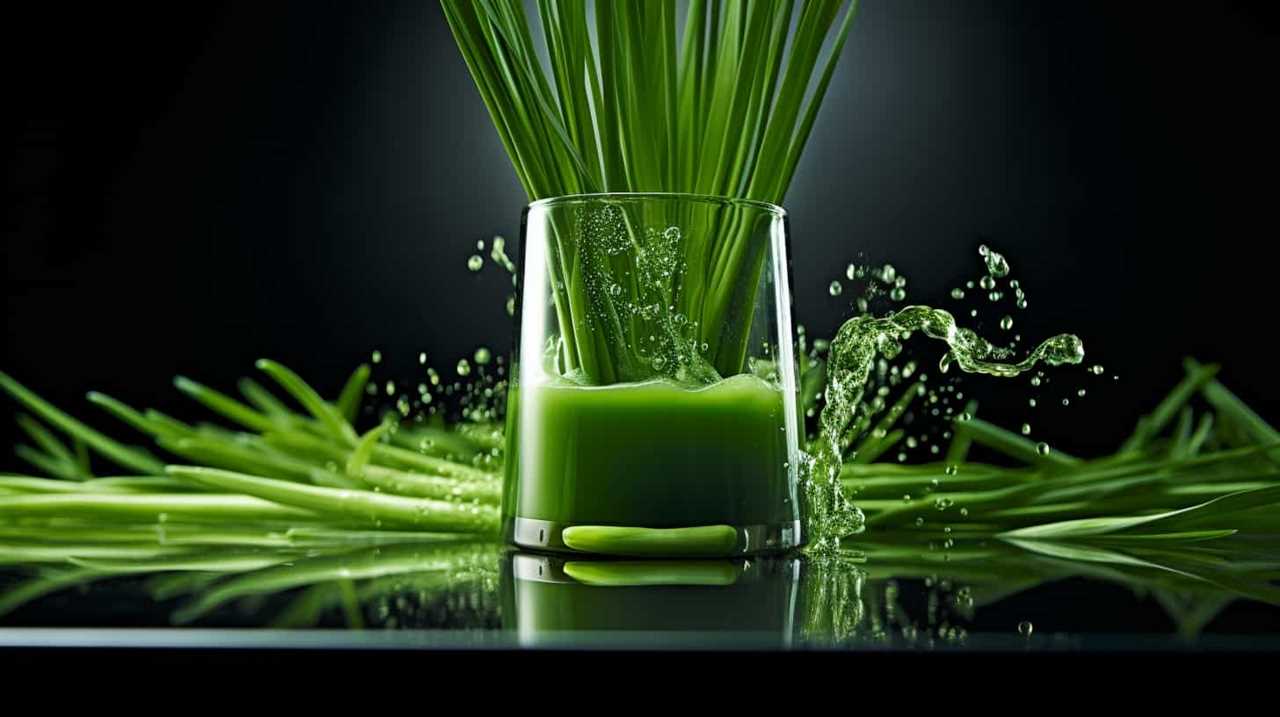
Now, let’s move on to discuss the texture changes in orange juice.
Texture Changes in Orange Juice
As we explore the texture changes in orange juice, it’s important to note that certain factors can cause it to become thicker or develop sediment. One common texture change in orange juice is pulp separation, where the pulp separates from the liquid and settles at the bottom. This can occur naturally over time, as the pulp particles become denser and sink.
Another factor that can affect the texture of orange juice is the expiration date. As orange juice ages, it may start to develop a thicker consistency and even form sediment. This is a result of the natural breakdown of the juice’s components. Therefore, it’s crucial to check the expiration date on orange juice and consume it before it reaches its expiration date to avoid any undesirable texture changes.
Mold or Growth in Orange Juice
We need to be aware of the possibility of mold or other growth occurring in orange juice. Mold can develop in orange juice if it isn’t stored properly or if it has passed its expiration date.
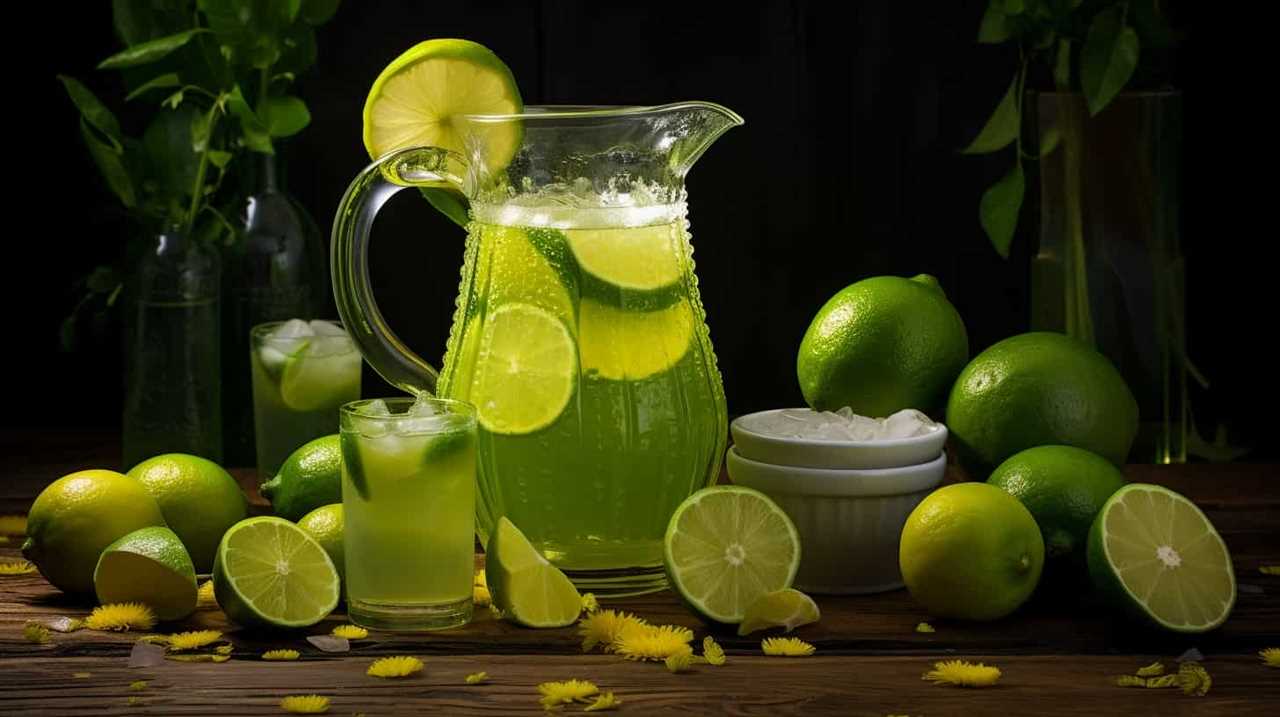
To prevent mold growth, it’s important to follow these steps:
- Store orange juice in the refrigerator at a temperature below 40°F (4°C).
- Check the expiration date on the bottle before consuming. Discard any orange juice that has expired.
- Keep the container tightly sealed to prevent air and moisture from entering, as these can promote mold growth.
Regularly inspecting orange juice for any signs of mold or unusual growth is essential. If you notice any discoloration, a strange odor, or visible mold, it’s best to discard the juice to avoid any potential health risks.
Frequently Asked Questions
Can Orange Juice Go Bad if It’s Stored in the Freezer for Too Long?
Frozen orange juice can potentially lose its nutrients and change its taste if stored in the freezer for too long. It is important to check for signs of spoilage before consuming it.
How Long Can Orange Juice Stay Fresh in the Refrigerator Once It’s Opened?
Once opened, orange juice can stay fresh in the refrigerator for about 7-10 days. To maintain its freshness, store it properly by keeping it tightly sealed and at a consistently cold temperature.
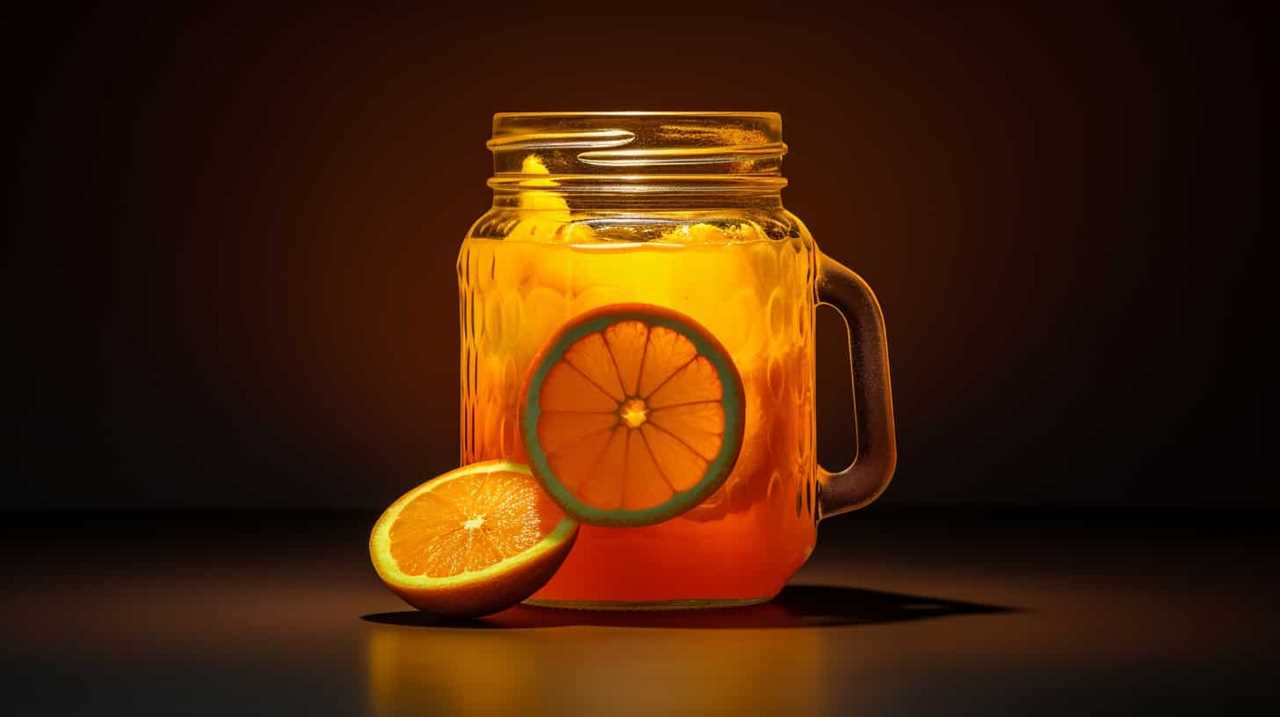
Is It Safe to Consume Orange Juice That Has Been Left Out at Room Temperature Overnight?
Left out orange juice may not be safe to drink as it can harbor harmful bacteria. Signs of spoiled orange juice include a sour smell, mold growth, and a change in color or taste.
Can Orange Juice Develop Harmful Bacteria if It’s Past Its Expiration Date but Still Looks and Smells Fine?
Orange juice can cause food poisoning if it develops harmful bacteria, even if it looks and smells fine. Signs of spoiled orange juice include a sour smell, mold growth, and a change in color or taste.
Does the Nutritional Value of Orange Juice Decrease as It Starts to Go Bad?
As orange juice goes bad, its nutritional value decreases. The longer it sits on the shelf, the more nutrients it loses. Signs of spoilage include a sour smell, off taste, and mold growth.
Conclusion
In conclusion, determining if orange juice is bad requires careful observation of color changes, strange smells, off taste, and texture changes. Just like a detective investigating a case, we must rely on our senses to detect any signs of spoilage.
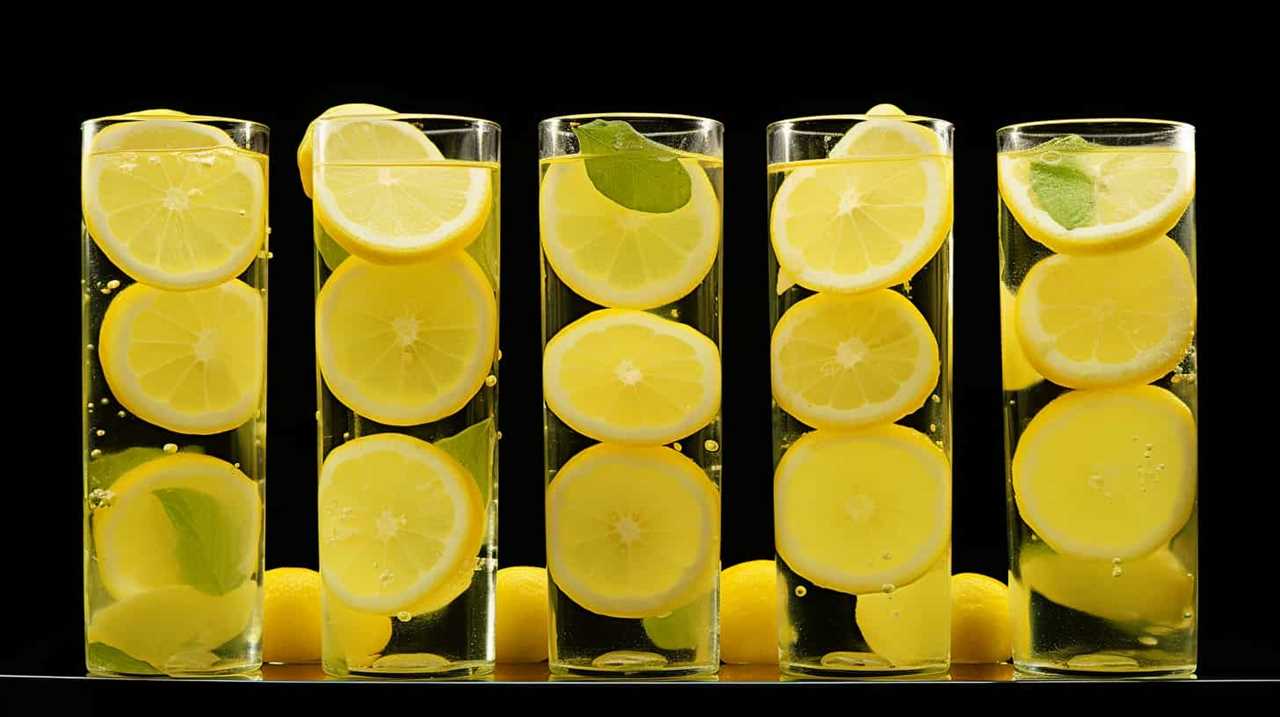
If we detect mold or growth in the orange juice, it’s a clear indication that it’s no longer safe to consume. By remaining vigilant and attuned to these indicators, we can ensure that our orange juice is always fresh and enjoyable.
Susannah expertise lies in researching and compiling evidence-based content on juicing, nutrition, and overall health. She is committed to ensuring that The Juicery World offers accurate, up-to-date, and trustworthy information to empower readers to take control of their health. Susannah’s goal is to inspire individuals to embrace juicing as a way to nourish their bodies and live their best lives.
-

 Juice Tips and Tricks3 months ago
Juice Tips and Tricks3 months agoHow Much Lemon Juice Is Equal To Half A Lemon
-

 Juice Tips and Tricks3 months ago
Juice Tips and Tricks3 months agoHow Long Can You Drink Orange Juice After The Expiration Date
-

 Fruit Juice Varieties3 months ago
Fruit Juice Varieties3 months agoTop 11 Most Loved Fruit Juice Varieties
-

 Juice Tips and Tricks3 months ago
Juice Tips and Tricks3 months agoHow Much Lemon Juice Is Equivalent To 1 Lemon
-

 Organic and Natural Juices3 months ago
Organic and Natural Juices3 months ago8 Best Organic Brands for Fruit Juice
-

 Juice Tips and Tricks3 months ago
Juice Tips and Tricks3 months agoHow Much Lemon Juice Is Equivalent To One Lemon
-

 Juice Manufacturing Process3 months ago
Juice Manufacturing Process3 months ago9 Best Steps in Industrial Juice Manufacturing Process
-

 Juice Tips and Tricks3 months ago
Juice Tips and Tricks3 months agoHow Long Can You Drink Juice After The Expiration Date







